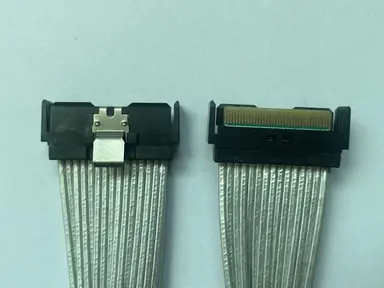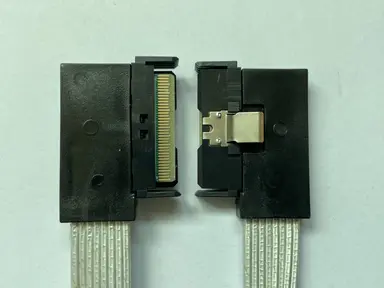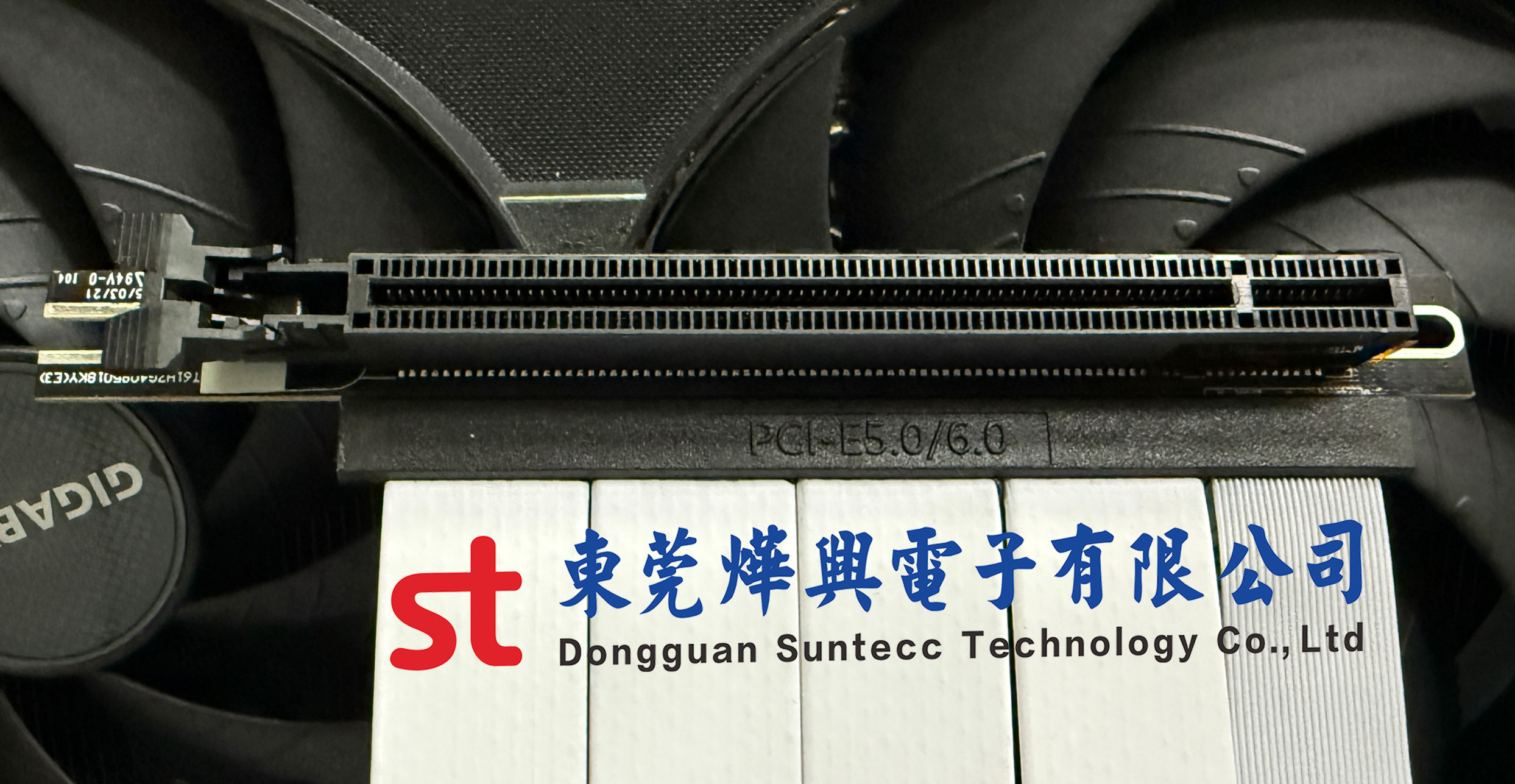- News Category
- Industry News
- Product Information
- FAQ
- Customer Cases

MCIO vs SlimSAS Upgrade Guide|Server High-Speed Transmission Solutions
Facing the challenges of PCIe Gen5/Gen6 and AI data center bandwidth surge coupled with motherboard space constraints, how to smoothly upgrade from SlimSAS to MCIO (SFF-TA-1016), or adopt a "hybrid deployment" to accommodate both existing storage and new-generation accelerator high-speed channels, has become an industry focus. Dongguan Suntecc Technology Co., Ltd. presents this guide to provide system architects and data center managers with key technology comparisons, decision points, and upgrade roadmap.
Dongguan, September 19, 2025 — Dongguan Suntecc Technology Co., Ltd. today released the "MCIO vs SlimSAS Upgrade Guide | Server High-Speed Transmission Solutions" on its official website. As server platforms rapidly evolve from PCIe Gen4 to Gen5/Gen6, the demands for bandwidth, signal integrity, and wiring flexibility from AI training, CXL memory expansion, and high-speed NVMe storage are急剧攀升 (sharply increasing); the industry is gradually transitioning from traditional SlimSAS (SFF-8654) to higher density, higher speed MCIO connection solutions. This guide helps users accurately grasp the timing of technological transition and reduce upgrade risks.
"After PCIe entered Gen5, the cost and signal integrity risks of pure PCB long-distance traces increased significantly. MCIO's 0.60mm fine-pitch, high-density design allows us to create cleaner high-speed channels in limited space while maintaining compatibility flexibility with the existing SlimSAS storage ecosystem." — said the Technical Director of Dongguan Suntecc Technology.
Why evaluate upgrading from SlimSAS now?
- Bandwidth generation leap: Upgrading from SAS4 / PCIe Gen4 (~16GT/s/24Gb/s) to PCIe Gen5 and even Gen6 (32GT/s / 64GT/s) doubles the transmission rate, putting greater pressure on the loss budget of connectors and cables.
- Density and airflow optimization: 0.6mm fine-pitch high-density internal cables (SlimSAS, MCIO) can integrate more channels at the board edge, improving chassis airflow, which is particularly important for high-power consumption AI servers.
- Reduce Total Cost of Ownership (TCO): Using internal cable "Fly-Over" to bypass long PCB traces can reduce the use of expensive low-loss materials or multi-stage retimers, optimizing system cost and power consumption.
SlimSAS (SFF-8654) Technology Brief
SlimSAS (including Low Profile version) is a high-density internal storage/high-speed signal connector developed by the SFF committee, commonly available in 4i (x4) and 8i (x8) configurations, supporting SAS4 24Gb/s and PCIe Gen4 16GT/s. Its small size and center-latch design make it suitable for motherboard-to-storage backplane, HBA, RAID, DAS applications, and it can be adapted via cables to devices like SATA, MiniSAS HD, U.2/NVMe, making it a popular solution during the transition period. The Low Profile version achieves a lower height with the same 0.6mm pitch, and some models claim extension to PCIe Gen5.
MCIO (Mini Cool Edge I/O, SFF-TA-1016) Technology Brief
MCIO is a high-density internal card-edge + cable interconnection standard for next-generation servers and data centers, featuring 0.60mm pitch, center latch, supporting vertical or right-angle installation; natively supports PCIe Gen5 and has the capability to extend to Gen6/64Gbps (PAM4). It offers various pin counts like 38/74/124/148, distinguished by pin number rather than fixed channels; sideband pins can be converted to high-speed differential pairs, supporting x4, x8, x16, and even higher channel expansion. With excellent scalability in high-frequency environments and long-distance cable options, MCIO is rapidly gaining popularity in AI/HPC servers, CXL memory expansion, networking, and storage applications.
Market Application Examples
- Multi-GPU AI Servers: ServeTheHome reported on the ASRock Rack 6U8X-EGS2 H200 NVIDIA HGX H200 system, where the motherboard's trailing edge is densely populated with MCIO connectors, noting up to 20 PCIe Gen5 MCIO ports used for module interconnection, indicating widespread adoption of MCIO in high-density GPU platforms.
- FPGA/CXL Prototyping: Intel Agilex FPGA I-Series development kit documentation indicates that CXL or PCIe interfaces use two 74-pin MCIO connectors to connect to external hosts or custom daughter cards, demonstrating the practicality of MCIO in prototyping and memory expansion scenarios.
MCIO vs SlimSAS: Engineering Key Points Quick Reference Table
Feature MCIO (SFF-TA-1016) SlimSAS (SFF-8654) Upgrade Insight Speed Generation PCIe Gen5 Ready; roadmap to Gen6/~64Gbps PAM4 SAS4 24Gb/s, PCIe Gen4; some designs预告 Gen5/higher New-gen high-bandwidth systems lean towards MCIO Pitch / Form Factor 0.60mm; low-profile vertical/right-angle 0.6mm; standard and Low Profile heights Similar size, low redesign burden Pin Count Options 38 / 74 / 124 / 148; sideband convertible to high-speed 4i / 8i (corresponding to x4 / x8) Choose MCIO for greater than x8 or flexibility needs Protocol Flexibility PCIe / CXL / NVMe / SAS SAS / SATA / PCIe Gen4 MCIO recommended for heterogeneous workloads Fly-Over Distance / SI Aspect Supports long-distance high-speed, PAM4; can reduce retimers Mature for storage distances; long-distance high-speed needs evaluation MCIO suitable for high-speed backplanes, CPU↔GPU Upgrade Practical Advice (3+1 Steps)
- Lock target speed/generation: If PCIe Gen5 is needed short-term or Gen6/PAM4 is planned, prioritize MCIO backbone; pure storage maintaining Gen4 can暂时保留 (temporarily retain) SlimSAS.
- Inventory channel density and board edge space: For beyond x8 or multi-interface aggregation (AI acceleration, CXL, NVMe expansion), choose 74/124 pin MCIO to reduce connector count; pure storage backplanes use SlimSAS 4i/8i for cost-effectiveness.
- Hybrid adapter transition: Use cable assemblies like SlimSAS↔SATA, SlimSAS↔U.2, MCIO↔U.3/EDSFF to preserve existing assets, gradually converting high-speed sections.+1. Reserve OCP DC-MHS / M-XIO support: If the product roadmap leans towards modular servers, consider using M-XIO (integrated high-speed + power) based on MCIO for long-term planning.
Future Outlook: OCP DC-MHS and M-XIO
OCP Data Center Modular Hardware System (DC-MHS) is committed to improving data center hardware deployment efficiency through modularity; the TE M-XIO Brochure indicates M-XIO is based on MCIO and complies with SFF-TA-1033 and OCP DC-MHS specifications, integrating high-speed signals and high-power pins in a single 0.6mm interface, with a roadmap supporting PCIe Gen5/Gen6, beneficial for subsequent modular design.
Conclusion
SlimSAS still holds cost and compatibility advantages for existing SAS/PCIe Gen4 storage architectures; however, as systems move towards channel densities higher than x8, PCIe Gen5/Gen6, AI acceleration, and CXL expansion, MCIO, with its higher data rates, scalable pin counts, and fly-over wiring capabilities, is becoming the new backbone of data centers. If you are planning the next generation of servers or storage platforms, please contact Dongguan Suntecc Technology for evaluation kits, cable samples, and design integration support.
Address: NO.130, San Jiang Industrial Area , Heng Li Township, Dongguan City, China.
2025-09-19
MCIO Cables - PCIe Gen5 High-Speed Interconnect Solution
PCIe Gen5 High-Speed Interconnect Solutions: Dongguan Suntecc Empowers Next-Gen Data Centers with Innovative MCIO Cables
With the rapid advancement of artificial intelligence, high-performance computing, and cloud services, data centers face increasingly stringent demands for data transfer bandwidth and efficiency. PCI Express® Gen5 technology, delivering 32 GT/s per lane (doubling the bandwidth of PCIe Gen4), has emerged as the core engine of next-generation infrastructure. The MCIO (Mini Cool Edge IO) connector, as a critical physical layer solution, is redefining high-speed interconnect standards. Leveraging its expertise in high-speed cable solutions, Dongguan Suntecc Technology Co., Ltd. introduces high-performance MCIO cable assemblies, providing reliable and efficient PCIe Gen5 interconnect solutions for global customers.
PCIe Gen5 Advantages: Leap in Performance and Efficiency
PCIe Gen5 not only achieves a breakthrough in bandwidth (128 GB/s bidirectional bandwidth for x16 lanes) but also empowers modern computing through:
- Low Latency and High Energy Efficiency: Optimized protocol stack and encoding schemes reduce data transfer latency and improve efficiency per power unit.
- Backward Compatibility: Seamless integration with PCIe Gen4/Gen3 devices protects existing investments.
- Flexible Topology: Supports multi-lane configurations (x1/x4/x8/x16), adapting to diverse bandwidth requirements.
MCIO Connector: The Physical Layer Core for High-Speed Interconnects
MCIO (Mini Cool Edge IO) is a high-density connector system based on the SFF-TA-1016 standard, designed for protocols such as PCIe Gen5/Gen6, CXL, and UCIe. Its key advantages include:
- High Density Layout: With a pitch of only 0.60mm, it supports up to x16 PCIe 5.0 lanes in compact spaces, significantly enhancing interface efficiency.
- Excellent Signal Integrity: Optimized impedance matching (100Ω differential impedance), resonance suppression, and reduced crosstalk ensure reliable data transmission for 32 GT/s NRZ and 64 GT/s PAM4 signals.
- Thermal Management and EMI Performance: The low-profile "Cool Edge" design optimizes thermal airflow, while shielding structures minimize electromagnetic interference, making it suitable for high-density server environments.
- Layout Flexibility: Straight, right-angle, and 90° cable orientations adapt to various spatial constraints and routing needs.



Dongguan Suntecc's MCIO Cable Solutions
Dongguan Suntecc offers a full range of MCIO cable assemblies based on proprietary technology, featuring:
- High-Performance Materials: Utilizes 30 AWG shielded cable, thick-gold-plated terminals, and high-temperature insulation to ensure low insertion loss and long service life under high-frequency signals.
- Customized Designs: Supports MCIO-to-MCIO, MCIO-to-SlimSAS, MCIO-to-EDSFF, and other interface combinations for motherboard-SSD backplane, CPU-GPU, and CPU-CXL memory expansion connections.
- Rigorous Quality Control: Impedance consistency testing, eye diagram analysis, and hot-plug endurance validation ensure compliance with PCI-SIG Rev6.0 standards and system stability.
Application Scenarios: Empowering AI, Data Centers, and HPC
- AI Training Clusters: PCIe Gen5 and MCIO cables provide high-bandwidth interconnects for 10,000-card GPU clusters, reducing data exchange bottlenecks and improving training efficiency.
- Cloud Servers and Storage: Enables high-speed connections between NVMe SSD arrays and CPUs/accelerators for low-latency data access.
- Heterogeneous Computing Architectures: Connects memory expansion devices via CXL protocol, enhancing resource utilization and supporting memory pooling and sharing.
Conclusion: A Strategic Choice for Future Data Ecosystems
The combination of PCIe Gen5 and MCIO technology provides a foundational interconnect solution for next-generation data centers. Through innovative cable design and manufacturing processes, Dongguan Suntecc helps customers address the challenges of high-speed signal transmission, building efficient and reliable computing infrastructure. As the PCIe Gen6 standard evolves, the company will continue to invest in R&D, providing core connectivity components for global digitalization.
2025-09-19
❓ What is "PCIe 5.0 X16 Riser Cable"? How is it different from previous versions?
❓ What is a PCIe 5.0 x16 riser cable?
A PCIe riser cable is an extension cable that "extends" the PCIe slot on the motherboard, allowing the graphics card to be placed in a different position or mounted upright. PCIe 5.0 x16 indicates that this cable is designed to support PCIe Generation 5 (PCIe Gen5) and x16 lane speed/pin configuration.
🔌 What is the compatibility of a PCIe 5.0 x16 Riser Cable (adapter extension cable), can it be used with a PCIe 5.0 Riser and a PCIe 4.0 graphics card?
The compatibility of a PCIe 5.0 x16 Riser Cable needs attention to the following points:
- Physical interface and protocol compatibility: The PCIe 5.0 standard itself has downward compatibility. This means that PCIe 5.0 adapter cables can usually be used for PCIe 4.0 or earlier devices, but the device's speed will be limited by its own PCIe version.
- Board and device support: The premise of using a PCIe 5.0 x16 Riser Cable is that both your motherboard and the device you need to connect (such as a graphics card) must support PCIe 5.0. Not all motherboards and devices currently support PCIe 5.0.
- Signal integrity challenges: The high speed of PCIe 5.0 requires extremely high signal integrity. Low-quality or too long adapter extension cables may cause signal attenuation, data errors, or even device not recognized or performance degradation. Therefore, choosing high-quality cables is very important. We self-design multiple high-shielded cables and PCBs, all of which have passed strict signal integrity tests and comply with PCI-SIG specification standards.
- Potential issues: There have been reports that some graphics cards (such as NVIDIA RTX 5090) may experience compatibility issues when using PCIe adapters or extension cables, such as game errors or system blue screens. If you want to ensure Gen5 bandwidth and stability, you should use a Riser that is clearly marked to support PCIe 5.0. Some motherboards or BIOS/chipsets also have differences in actual Gen5 support, which may affect the final result.We can customize PCB layout and cable specifications according to different platform usage scenarios to meet various platform requirements.

⚡ Will using a PCIe 5.0 x16 Riser Cable cause performance loss?
In an ideal situation, using a high-quality and well-designed PCIe 5.0 x16 Riser Cable should not cause significant performance loss.
However, if the adapter cable is of poor quality, too long, or has insufficient shielding, it may introduce signal integrity issues, leading to performance degradation or instability. The risk of performance loss for gamers and DIYers comes more from the quality of the cable itself rather than protocol downgrade. We self-design multiple high-shielded cables and PCBs, all of which have passed strict signal integrity tests and comply with PCI-SIG specification standards. We provide protection for the needs of gamers and professional users.
💡 How to choose a PCIe 5.0 x16 Riser Cable?
When purchasing, you can pay attention to the following points:
- Confirm your needs: First, make sure whether your motherboard and device support PCIe 5.0.
- Choose a reliable brand and model: Prioritize brands with good reputation and professional technical background. For example, our company's PCIe Gen5 x16 extension cables (length and cable specifications can be flexibly customized) are mentioned to provide excellent signal quality. Also, test results show that adapter cards with full-length PCIe x16 slots may perform better in stability and compatibility.
- Pay attention to craftsmanship and heat dissipation: High-quality adapter cables usually use good shielding layers to reduce electromagnetic interference (we use self-designed high-shielded cables and have passed strict signal integrity tests). For devices such as M.2 adapter cards, metal heat sinks help ensure stable operation of high-speed SSDs at low temperatures.
- Pay attention to length: Under the premise of meeting installation requirements, try to choose shorter lengths, because longer cables usually mean a higher risk of signal attenuation.
🤔 Besides graphics cards, can PCIe 5.0 Riser Cables be used for other devices?
Yes, PCIe 5.0 Riser Cables are not limited to graphics cards. They can also be used for other devices that require PCIe 5.0 high-speed connections, such as:
- High-performance PCIe 5.0 NVMe SSDs: Install the SSD in a more flexible position through an adapter card.
- High-speed network adapters: such as 10G network cards or InfiniBand cards.
- Professional capture cards, computing cards, and other expansion devices that require high bandwidth.
❓ How long can a Riser cable be? Does the length affect it?
Theoretically, the shorter the better (it is easier to maintain signal integrity). Gen5 has low tolerance for signals and crosstalk, so length, shielding, cable material, and connector design will significantly affect usability. We offer different lengths (e.g., 50–300mm), and custom long-length cables can consult us for feasibility design schemes.
2025-09-18
